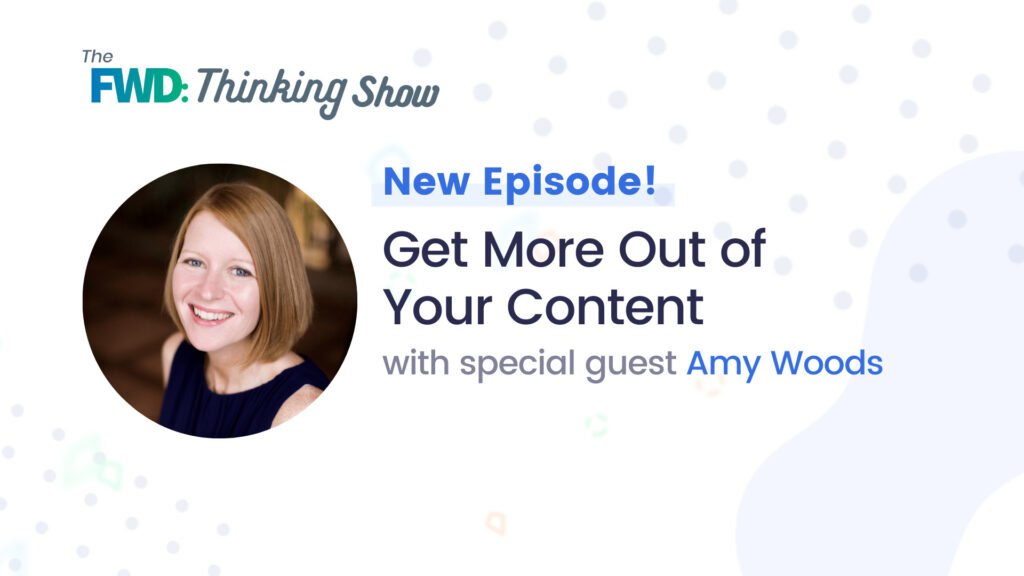By Kelly Forst February 1, 2021
Content repurposing isn’t copying and pasting content from one format to another. It’s a strategic process that when done correctly, can change the way you market for the better.
To Amy Woods, Founder of the creative agency Content 10x, creating amazing content is all about discoverability, credibility, and establishing trust among your audience.
But the thing is, your audience probably consumes your content in different ways. Some people prefer reading blog posts, others like to catch up on your Instagram stories, and others may like to watch videos. And by creating content for all these channels, you’re checking the box for all three things above.
So how do you do it all?
The answer: content repurposing.
Content repurposing is about finding different ways to communicate with your audience through different formats. It means figuring out your core message in a piece of content, and communicating it across channels.
But if you’re worried about being overwhelmed, sounding like a broken record, or connecting with your audience in multiple places, Amy will put your mind at ease in the latest episode of The FWD: Thinking Show.
What is content repurposing?
Content repurposing is the act of creating content for multiple communication channels.
But what type of content can you repurpose? Any type of content can be repurposed for multiple mediums — including blog content, podcasts, videos, email content, search engine optimized content, online courses, social media content, and so much more.
When figuring out what content you’re going to create, you need to first understand your audience. Talk to your customers. Listen to the language they use and figure out how you can resonate with like-minded people.
Then, Woods advises going all in on one channel at a time. Be streamlined and episodic in the type of content you create. Start by repurposing content for one channel at a time, and introduce additional channels over time.
A great place to start is with your existing content that’s still current and relevant. This is called evergreen content, and generally it’s timeless, great content that your audience will benefit from.
How do I repurpose content without sounding repetitive?
Sounding repetitive is a common concern among businesses who are repurposing content for the first time.
Woods says breaking down the content in creative ways and being very platform specific wil help you avoid sounding like a broken record. While you may have the same message in repurposed content, the way you communicate it will be different.
Woods advises you ask the following questions with the eye of a journalist:
- What are the stories and angles in this piece of content?
- What are the questions that arise?
- Where can you take the different angles and repurpose it to go down different avenues?
How do I start repurposing content?
At first, the process of repurposing content can feel overwhelming. But Woods offers great advice for those just starting out.
Step 1: Go all in on one consistent form of content: do you want to go the podcasting route? Video content and do a weekly video show? Want to blog regularly? Or live stream?
Woods says creating high quality content comes down to committing to one type of content, getting really good and consistent at that, and then repurposing that piece into other formats.
Step 2: Make sure your process is easily repeatable for every piece of content you create.
Use a tool like Trello to manage your project and create checklists for every piece of content you create and put in your repurposing action.
Step 3: Schedule your content. If it’s evergreen content, you are not bound by time restrictions when you schedule.
However, be aware that driving traffic to your blog or website when content first posts through email marketing and social media can benefit your discoverability.
Step 4: Don’t create more content until you repurpose your first. You aren’t doing justice to that first piece of content until you repurpose it.
Woods’ #1 tip: Consistency. Focus on something that’s episodic. Try to embrace content that posts with regular frequency so people know what to expect and can become fans over time.
Podcast Episode Resources
Episode Timestamps:
- 1:15 — Hear Amy’s entrepreneurial story.
- 5:35 — Why you need a content strategy — even if you don’t like writing.
- 9:30 — How small businesses can learn about their audience and create content that addresses their problems.
- 12:30 — Content repurposing: What it is and why you should be doing it.
- 18:15 — Repurposing is not repetitive.
- 23:40 — How to organize your thoughts and what type of content works best on which channels.
- 35:00 — What kind of content works best in email marketing.
- 38:30 — Content marketing predictions for 2021.
- 43:10 — Amy’s top recommendation for people just starting out in online marketing.
About Amy Woods
Amy Woods is the founder of the creative agency, Content 10x, which helps businesses, entrepreneurs, influencers, and thought leaders maximize their audience reach by repurposing their original content. Amy is a trusted speaker at Podcast Movement, Podcast, Content Live, Agency Transformation Live, Retail Live, and Youpreneur Summit. Prior to striking out as a digital entrepreneur, Amy worked as a management consultant with Accenture for 13 years.
Connect with Amy on LinkedIn and Twitter. And check out her business Content 10X.
